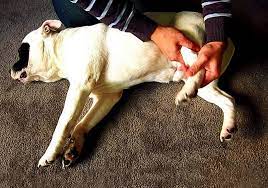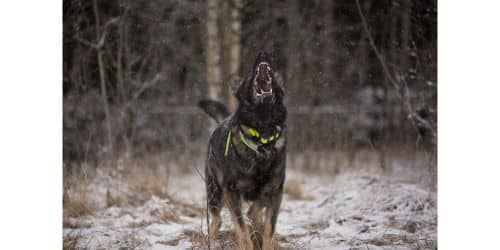Just like humans, when we get injured or have a fracture/dislocation on our ankle or knee, several reasons could lead to the limping of a dog. The essence of this post, therefore, is to enlighten you on the several reasons why dogs limp so that you can at least have an idea before deciding to take your dog to the vet.
Dogs don’t start limping out of the blue without a cause, and it’s important to find out the cause(s) of why they started doing so. For this, we have listed 9 possible causes why the same dog that was 100% active yesterday is literally limping around the house today.
Read Also: DOG NESTING: Reasons For Nesting Behaviours in Dog
9 Possible Reasons Why Your Dog is Limping
The following are the common causes of limping in dogs
#1. Injuries or Trauma
Injuries and trauma are the most evident causes of limping in a dog. Our dogs are vulnerable to virtually as many forms of injuries as humans are, ranging from traffic accidents to sports injuries. Furthermore, broken bones, fractures, sprains, dislocations, ligament rips, joint damage, and spinal injuries can all cause moderate to severe limping in dogs, and in severe situations, the dog may be unable to bear weight on the affected limb at all.
Although proper conditioning can help reduce the likelihood of certain sports injuries, a limping dog athlete should be given plenty of rest until the reason for the limp is diagnosed and treated.
#2. Paw Injuries
You know how it feels to have something sharp lodged in your foot if you’ve ever landed on a sharp object. Glass, nails, sticks, thorns, and anything else that shouldn’t be in your dog’s paw actually hurt too. They make walking difficult and might lead to infection.
Tenderness and limping can also be caused by insect and animal stings or bites, as well as lacerations, broken toenails, burns, and bruising. Additionally, your dog licking his paw continuously is a symptom that he may have something caught in his paw that may lead to its limping.
#3. Ageing
Ageing answers the ‘why is my dog limping’ question. Just like in humans, dogs’ bones weaken as they age, and their muscles become stiff. In this case, have your dog’s osteoarthritis evaluated by a veterinarian and, if necessary, switch to a portion of dog food formulated to improve bone and joint health. Supplements could be useful.
#4. Panosteitis
Acute panosteitis is a limb illness that typically affects large-breed puppies between the ages of 5 and 12 months. It might continue for several months and alternate between various legs. Your puppy will most likely grow out of it by the age of two, but it is advisable to see a vet to ensure that it is healing properly and to manage any pain your dog is feeling.
#5. Knee Issues
Dogs frequently develop a medial luxating patella, which results from the kneecap becoming dislodged from its normal position in the groove. An ACL tear might result from this. Furthermore, your dog may experience pain and discomfort if the kneecap is knocked loose or torn partially or entirely.
They might be less inclined to “rabbit hop,” or take steps with both of their back legs simultaneously, while walking. Age, weight, and certain breeds’ genetic propensity for ACL rupture can all result in the limping of your dog.
#6. Bone Condition
Some illnesses can make your dog limp because they affect the bones in their legs. Younger dogs, particularly puppies of large breeds, are susceptible to developing painful walking diseases such as panosteitis and hypertrophic osteodystrophy. For the best prognosis, it’s important to get a quick diagnosis of some tumours, such as osteosarcoma, which also affect the bones.
#7. Dysplasia
Your dog may limp due to hip and elbow dysplasia, which weakens and dislocates joints. Dysplasia is more common in larger breeds like the Mastiff, Rottweiler, and Golden Retriever, yet genetics also make some tiny breeds like Pugs and Bulldogs susceptible. Dysplasia can be noticed in a dog by limping as well as difficulty lying down and rising.
#8. Problems with the claws
When a dog does not often walk on rougher surfaces such as pavements and cement, the claws do not wear down. They could be digging into your dog’s skin, which would be quite painful. To avoid this, keep your dog’s nails cut and walk them on a regular basis.
#9. Over-exertion
Your dog could be exhausted or have overstretched a muscle if you ran up to 5 kilometres with him or her or engaged in a strenuous game of fetch. By the next day, it ought to be okay. However, you should consult a veterinarian if it appears stiff a few days after the activity because it could be an indication of more serious joint or muscle problems.
OTHER REASONS
There are still other causes for your dog’s lameness. It could be a side effect of an infection, such as Lyme disease, or a bone malignancy, such as osteosarcoma. If you have a large breed puppy, such as a Great Dane, they may limp owing to disorders such as hypertrophic osteodystrophy or panosteitis.
A range of tests will be performed by your veterinarian in order to determine exactly what is wrong. Your vet may use radiographs, biopsies, and blood tests to determine why your dog has begun limping.
Gradual vs. Sudden Limping
The limping of a dog can be either sudden or gradual. Sudden limps, as the name implies, occur suddenly, whereas gradual limps occur slowly over time. Knowing if your dog’s limping is sudden or gradual might help your veterinarian narrow down the causes and help you evaluate if your dog needs a veterinary emergency.
A sudden limp in dogs is frequently the result of an instant injury or trauma. Gradual limps, on the other hand, are typically caused by an underlying chronic or degenerative illness such as osteoarthritis or dysplasia. Keep in mind, however, that you should not put off scheduling an appointment because your dog has a gradual limp. Some causes of gradual limping, such as bone cancer or hip dysplasia, can be treated if they are identified much sooner than later.
How to Tell Which Limb a Dog Is Limping On
It’s quite difficult to tell which leg a dog is favouring when they have mild aches or difficulties affecting numerous legs. You should know that dogs prefer to shift their weight away from the leg which causes them the greatest discomfort.
For example, the dog limping with the forelegs will elevate their heads when the injured leg contacts the ground and lower their heads when the good leg bears weight. On the other hand, dogs with hind-leg lameness will lean forward to support their back end, and you should see their tail or afflicted hip raise as the injured limb meets the ground.
Identifying a Limping Dog
The reason for your dog’s limping may occasionally be obvious, such as a fractured bone or a piece of glass in the paw. Sometimes the root problem is a little harder to pinpoint.
Your veterinarian may need to perform several tests to ascertain the cause of your dog’s limping. Before contacting the veterinarian, you can perform your own checkup at home before contacting the veterinarian. Testing the range of motion and playing with your dog’s limbs without the correct training, however, is not a good idea and might further hurt your dog.
How to Treat a Limping Dog
Depending on the cause of your dog’s limping, the treatment will differ. Your dog’s treatment plan may be as simple as a few days of rest, or it may need surgery, medication, additional testing, and a lengthy recovery. While this may sound frightening, the sooner you get your dog to the veterinarian, the better the prognosis.
While you wait for your appointment, try to keep your dog as quiet as possible and refrain from exercise or play to avoid aggravating the issue, and crate your dog in the car if necessary to prevent further injury.
Conclusion
To sum up, if your dog limps for more than a few minutes, it is usually best to call your veterinarian. It may be okay to wait a few hours for limps that don’t seem to be troubling your dog too much. In some circumstances, the limping may even go away on its own while you wait. Your dog, though, can’t wait in some situations, therefore, immediate care must be given right away!
FAQs on Why is My Dog Limping
If my dog is limping but not whining, what does it mean?
Numerous conditions, such as muscle strain or ligament damage, might cause your dog to limp. Additionally, it depends on which leg is injured and precisely where the limb is injured. It is advisable to get your pet examined by a veterinarian who can do a lameness examination to pinpoint the location of the issue on the leg.
What kind of natural pain reliever may I give my dog?
- Hot and cold therapy for dogs’ natural pain relief.
- Ginger.
- Fish oil
- Turmeric.
- Boswellia.
- Devil’s Claw.
- CBD Oil
- Acupuncture.
Can a dog limp recover on its own?
Some limping will go away on its own. In many circumstances, the first step in treatment is rest and medicine particularly if your veterinarian detects a sprain/strain, arthritis, or other mild ailments.






